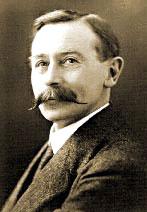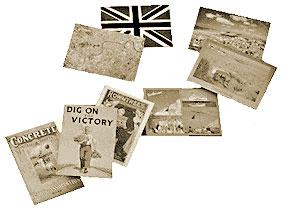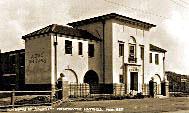There is every chance that the postcard you send home from your holiday in Abergavenny or York started life right here in Sussex. Because since 1902 Hastings has been the home of Judges, one of Britain’s leading publishers of quality picture postcards.
When Fred Judge arrived in Hastings at the turn of the century he could have had little idea of the worldwide impact he was to make on the business of postcard publishing. But Fred was a master with a camera and a natural entrepreneur.

In 1927 he built his factory on the site that we occupy to this day; and although the building has been developed and extended, the Italianate facade remains a famous landmark on the A259 coast road.
Since acquiring the business in 1984 we have undertaken a planned investment programme. We have extended the factory to accommodate modern pre-press, printing and finishing facilities. Our Heidelberg 74 -Speedmaster 5-colour press was partly funded by the Department of Trade and Industry who, in making the grant, recognised the importance that such a purchase represents in both commercial and employment terms.
Investment like this, together with sound management and an enthusiastic workforce, keeps us at the forefront of our industry enabling us to produce a first class product at a commercially viable price. This is why we look forward with real confidence to the challenges which lie ahead.
Fred Judge was born in Wakefield, Yorkshire, in 1872, where he started life as an engineer. Photography had always been his real interest and it was whilst visiting Sussex in 1902 that he made the decision to give up engineering for a career as a photographer.
He and his brother Thomas purchased an existing business at 21a Wellington Place, Hastings and here they set up as photographers and photographic dealers under the name of Judge’s Photo Stores.
Although the idea of sending an illustrated card through the post was not new (the first having appeared towards the end of the 19th Century) Fred Judge made his mark by setting himself extremely high artistic standards.
At first he concentrated on local scenes and activities. Having taken his pictures he would go straight back to the darkroom to make them into postcards – often for sale within a few hours; and the quality of his work was such that passers by would gather outside the shop window for a sight of his latest work.
One of his earliest successes was a photograph taken during a great electric storm in 1904, described by the following report in a local newspaper. “An extraordinary flash of lightning rent the heavens and lit up the gloomy surroundings … the picture shows a great streak of lightning from east to west dividing the filament in halves. The run on the postcards has been phenomenal and we advise all to secure a copy. It is worth treasuring.” Over 25,000 copies of “Lightning” were sold within the year, and it remained a best seller for more than a quarter of a century.


Two years later “Glory”, considered one of Fred Judge’s finest postcards, was published. This was a view of Hastings Old Town and Parish Church from the East Hill. What gave it its unique appeal was a sky filled with shafts of sunlight illuminating the Old Town and the distant prospect of the sea. “Glory” remained popular for many years with sales in the hundreds of thousands.
Success was also to come with larger format and landscape photography using the Bromoil process. This gave Fred Judge’s pictures their strongly impressionistic nature, rich in depth and tone: he won over 100 medals, and one-man exhibitions of his work were held in London, Washington, New York and Tokyo.
Meanwhile back in Hastings the business was expanding, necessitating moves to bigger and better premises culminating in the move in 1927 to the present, purpose built site. Branches at Ludgate Hill, the West Country and the Lake District were opened and the range of resorts and towns featured on the postcards extended.
Then one cold day in February 1950, a small procession climbed the East Hill in Hastings. It paused at a spot that overlooked the Old Town and there, to the cries of seagulls, ashes were scattered. Fred Judge had died at the age of 78 having built up an internationally respected company on his skills as a photographer and businessman.
The business was sold to another Judges photographer, Ernest Bartholomew, who invited Richard Lee and Robert Harrison to join him as directors. Under their ownership the company introduced lithographic colour printing and continued its expansion until their retirement.
Then in 1984 Judges became a real family concern once again when Bernard and Jan Wolford took over. Bernard had over 35 years experience in industry and management and his wife Jan, having run her own business, brought particular expertise to the company’s systems and factory organisation.
It became even more of a family business when their son Graeme, now Managing Director, joined: already with an Honours Degree in Business Studies, he completed his formal education with a year at the London College of Printing. Trevor, the younger son and now Sales Director, already had a wealth of shop floor experience having worked in the plant during every school holiday since his father took over. He took a degree in Graphic Design and Communications, including photography and computer graphics, before moving across to sales and marketing.
The present management can truly be said to be building on the foundations laid by Fred Judge over 100 years ago.
Reprinted from the Judge’s Website with the kind permission of Bernard and Jan Wolford.
Hastings Town March 2008
All articles, photographs and drawings on this web site are World Copyright Protected. No reproduction for publication without prior arrangement. © World Copyright 2015 Cinque Ports Magazines Rye Ltd., Guinea Hall Lodge Sellindge TN25 6EG